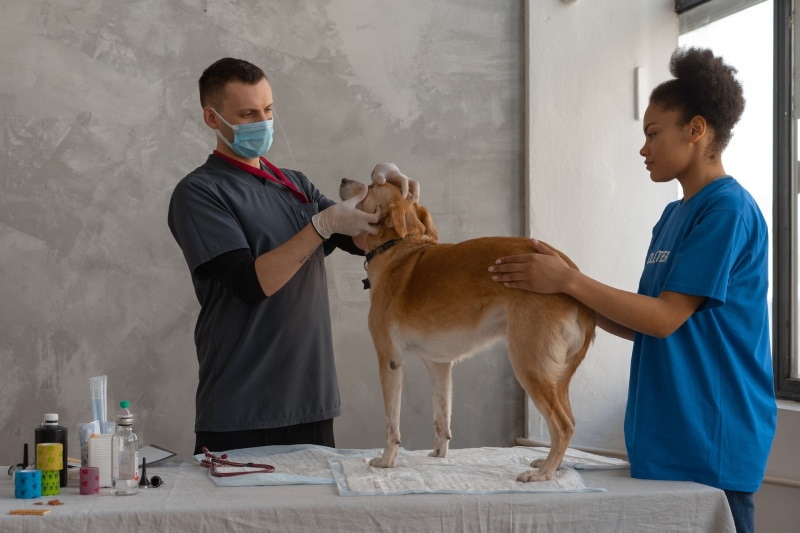In this article
Have you ever wondered what colors dogs like? Does Fido’s favorite treat look better when it’s presented in one color over another? It might be surprising to learn that dogs are indeed able to distinguish between different colors, and some have even been known to prefer or dislike specific shades. So, if you’re curious about how your pup perceives color, read on to learn more!

The Science Behind Color Perception in Dogs

Much like humans, dogs are able to perceive different colors. However, their ability to differentiate one hue from another is not as sharp as ours. While we can distinguish millions of colors, studies suggest that dogs are limited to only certain shades. As a result, they may not be able to recognize all of the colors in the spectrum.
Furthermore, just like humans, dogs have two types of color receptors in their eyes—rods and cones. The rods are primarily responsible for perceiving movement, while the cones are responsible for distinguishing colors. As a result, dogs are more likely to notice changes in light and dark shades rather than distinct colors.
Does Color Affect Dogs?
Although studies have found that dogs are able to perceive certain colors, this doesn’t necessarily mean they care about them. While some owners may swear their pups prefer blue over red or yellow over green, these anecdotal stories are not backed up by scientific evidence.
In fact, the majority of research suggests that color does not have a significant effect on canine behavior. One study even found that dogs were able to differentiate between colors when presented with food, but this had no impact on their willingness to eat it.

Do Dogs Show a Preference for Certain Colors?
Although research has suggested that color does not have a significant effect on canine behavior, there is evidence to suggest that some dogs may show a preference for particular colors. In one study, researchers observed how dogs responded when presented with food in various colors. While the majority of pups seemed indifferent to the hue, a few did show an aversion or even attraction to certain shades.
Overall, it’s safe to say that while your pup may have a slight preference for certain colors over others, this won’t necessarily affect their behavior or willingness to eat certain foods. So don’t worry if Fido turns his nose up at the blue treats—it simply means he likes yellow better!
What Does Color Look Like to a Dog?
Again, it’s impossible to say exactly how a certain color will look to your pup. However, studies suggest that dogs are able to see certain colors in the spectrum. For example, reds and oranges might appear as dark brown or gray shades, blues can appear as light purples or greens, and yellows may be seen as white or tan hues.

Dog Vision FAQ
Now that we’ve taken a look at color perception in dogs, let’s answer some of the most frequently asked questions about canine vision.
How well can dogs see in the dark?
Dogs have much better night vision than humans do. This is because they have more rods (the cells responsible for perceiving movement and light) in their eyes than humans do. As a result, they are able to see much better in low-light situations.
How far can a dog see?
A: On average, dogs have better vision than humans at distances up to 20 meters (65 feet). However, their field of vision is much smaller than ours—they are unable to take in as wide of a view from one spot. Therefore, it’s important to keep an eye out for potential dangers when walking your pup!
Can dogs see things humans can’t?

Dogs are able to see ultraviolet light, which is not visible to the human eye. This means they can see things that may be invisible or difficult for us to detect, such as urine trails left by other animals.
Do dogs have color blindness?
While research has suggested that dogs can perceive certain colors, it’s unlikely that they experience true color blindness like humans do. However, since their ability to differentiate between hues is not as sharp as ours, they may have difficulty recognizing certain shades.
Is color perception in dogs affected by breed?
The answer is not yet clear, but some studies have suggested that different breeds may perceive colors differently. As research on the subject continues, we may learn more about how canine vision varies from one pup to another.
How does vision vary between puppies and older dogs?
Puppies may have slightly better vision than adult dogs, as their eyes are still developing. However, this difference is not typically significant enough to affect color perception.
What other factors can affect canine vision?
Age, breed, and health are all factors that can influence a pup’s vision. Dogs with eye problems or certain diseases may have difficulty perceiving color, while older pups may find it harder to distinguish between hues. Additionally, exposure to bright lights or loud noises can cause temporary blindness in some dogs.
How can I help protect my dog’s vision?

Keeping your pup’s eyes clean and free from debris is a good start. Additionally, providing adequate nutrition and avoiding exposure to bright lights or loud noises can help keep their vision in tip-top shape. Finally, regular visits to the vet are crucial for detecting any issues with your pup’s vision early on.
Are there any other tips for maximizing my pup’s vision?
If you’re worried about how your pooch is perceiving the world, try playing with various toys and games in different colors. This can help them develop better color recognition skills over time, as well as boost their overall visual acuity!
Do dogs have different eye colors?
Yes! Dogs come in a wide range of eye colors, from bright blues to deep browns. The most common color is yellow or amber, but some breeds may have different hues as well.
Does my pup’s eye color affect his vision?
While it’s true that certain breeds may be predisposed to particular color recognition issues, any changes in your pup’s eyes should be discussed with your vet. Generally speaking, however, the color of your dog’s eyes shouldn’t have a significant impact on their vision.
What is basic eye first-aid for dogs?
If your pup’s eyes appear irritated, keep their head still and flush their eye with sterile saline or an artificial tear solution. It’s also important to keep the area around their eyes clean and free from debris. If symptoms persist, contact your vet for further advice.
If you need to speak with a vet but can't get to one, head over to PangoVet. It's our online service where you can talk to a vet online and get the advice you need for your pet — all at an affordable price!
What can I do if my dog has difficulty seeing?
If you suspect that your pup is having trouble with their vision, contact your vet right away. They will be able to conduct a thorough examination and determine the best course of action for restoring your pup’s sight.
How can I tell if my pup is having vision issues?
Common signs of vision problems in dogs include squinting, rubbing their eyes, excessive blinking, and poor responses to visual cues. If you notice any of these behaviors in your pup, contact your vet for further examination.
Are there corrective measures that can be taken for canine vision problems?
Depending on the underlying cause of the vision problem, certain corrective measures may be available. Your vet will be able to evaluate your pup’s condition and determine the best course of action for restoring their sight. In some cases, surgery may be required. However, the earlier any issues are detected, the greater chance there is for recovery.

Conclusion
So, while there is evidence suggesting that dogs can distinguish between certain colors and may prefer one shade over another, there is currently no solid proof that they’re significantly affected by specific hues. Ultimately, your dog’s favorite color likely has more to do with its individual personality than anything else! Nevertheless, feel free to experiment and find out what hue your pooch prefers. After all, you may just be surprised.
See also:
- Why Does My Dog Sleep on Their Back? (3 Reasons for This Behavior)
- Why Does My Dog Sleep With Me & Not My Husband? Reasons & Factors
Featured Image Credit: Ryan Brix, Shutterstock




















